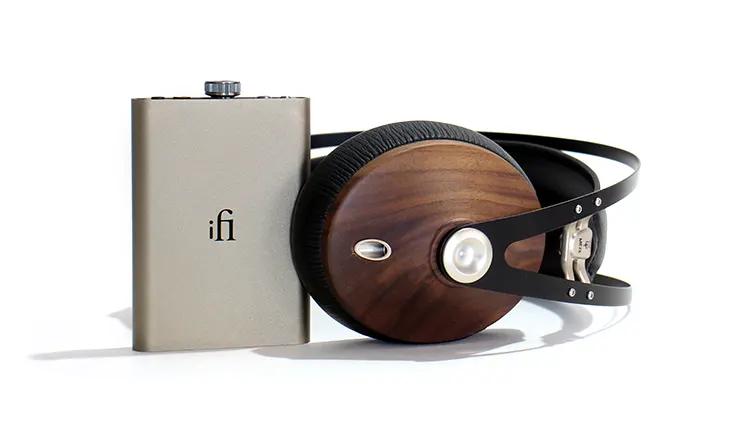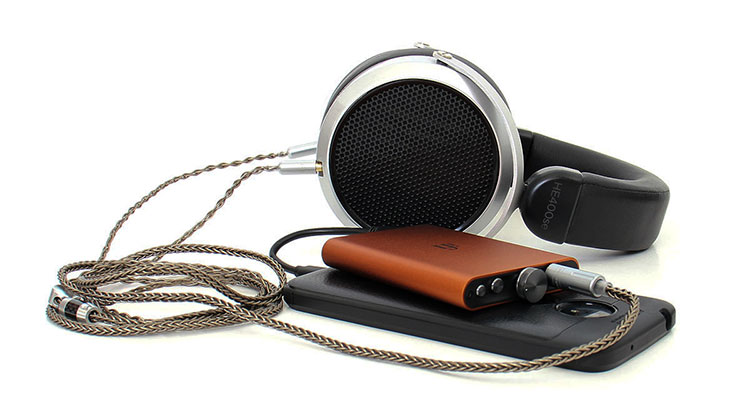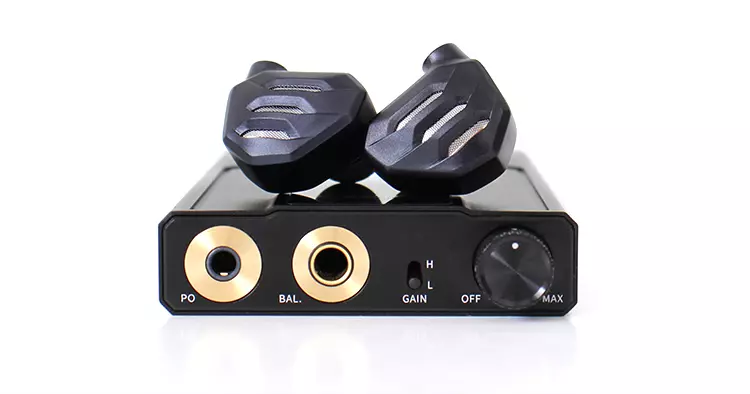Synergy
Power
The amplifier section seems powerful enough to power up most headphones adequately, particularly on the balanced connection. The real benefit of the balanced connector is not only more power on tap but better crosstalk control. Both outputs produce enough dynamism to overshadow that spec.
I would pair the iFi Audio hip-dac 3 with any headgear that is not overly power-demanding. The balanced output is powerful enough and is conservatively rated it seems and capable of driving most headphones I have at my disposal.
The iFi Audio hip-dac 3 is a small, pocket-friendly portable, battery-powered device, with a big attitude.
Pairings
What changes here is the addition of the IEMatch feature that brings the noise floor down to nill and the feature works particularly with IEMs. It also negates the slight channel imbalance naturally found on these volume pods. So that takes care of that.
The hip-dac 3 is mostly neutral in tone except when you engage the XBass feature. When you engage the XBass, things get interesting because it fills in the bass nicely on cans that are naturally low-frequency deficient.
I wouldn’t use it on cans that are naturally bass-capable like the MEZE Audio 99 Classics because it would overwhelm the bass and take it into boomy territory.
But for headphones like some of the HIFIMAN headphones that have a low bass shelf then it works almost fantastically. The bass thickens up and takes on extra space in the panorama, and much-needed body and texture.
Select Comparisons
Comparisons were made using my trusty and broken-in HIFIMAN Sundara. A custom cable was used to tap into the 4.4mm power from each unit.
In the case of firmware and filters, the iFi Audio hip-dac 3 was used with 7.4 and not the GTO variant. Just the same, the FiiO Q11 was using the non-oversampling filter.
iFi Audio hip-dac 2
Technical
This comparison is more like comparing a York Apple to a Gala variant than comparing apples to oranges. Coincidentally the hip-dac 2 dresses itself in an orange hue, Sunset Orange, that is.
Not much changed except for the color scheme. Both models use the same XMOS 16 core processing unit, custom iFi Audio OV OPamps, the same firmware, and the same button arrangement with the same features, minus the IEMatch.
Most of the changes were internal except for the addition of IEMatch. Improved filtering was used throughout the circuitry to bring down noise levels even further.
Design
Orange is not my favorite color but is one of my favorite fruits to eat. That and the additional IEMatch feature are the only external differences on the outer fascia. Both models seem to be made from the same mold.
Some of the manufacturing tolerances have improved, at a minimal level. For example, the hip-dac 3 has less button rattle compared to the other two variants.
Performance
If you only go by tonality, both these models use the same firmware and the same basic set of chips so it will be a tie since they both have an almost identical tonality.
The differences lie in that the hip-dac 3 has a darker background than the previous models. Did it achieve it by dropping the gain? No. It seems the gain is set higher on version 3 by a couple of decibels.
As the saying goes, practice makes perfect and iFi managed to improve the circuitry through careful placement and re-selection of filters. Not digital filters, circuitry filters.
But then you factor in the inclusion of the IEMatch feature and this enables the hip-dac 3 to offer twice the output gain level adjustability and that raises the synergy level to include IEMs that are ultra-sensitive while simultaneously alleviating any hiss production.
FiiO Q11
Technical
The FiiO Q11 is a different little beast in its own right since it offers more raw power at its output ports comparatively, so the cost of watt per dollar is considerably less here. It also seems to offer some features that the hip-dac doesn’t have, for example, a management app.
Instead of relying on custom parts, FiiO went to the parts bin and joined together an upscaled Cirrus Logic CS43198 SOC to drive an OPamp output stage. FiiO opted for a dual-crystal setup to keep the DAC section in check. The hip-dac 3 uses Femto instead.
The Q11 output stage manages to cough up 650mW per side on the balanced side but drops down to 165mW per side on the SE connector. The balanced side surpasses the hip-dac 3 by 250mW per side.
However, the S-Balanced iFi implementation is preferable and more powerful if you’re using single-ended gear. So the hip-dac 3 certainly caters to those who use 3.5mm connectivity.
One other aspect that the iFi hip-dac 3 has going for it is that it can do MQA. The FiiO Q11 only ventures into PCM and DSD decoding.
Design
The FiiO Q11 is also made of metal but it offers a different visual experience starting with the see-through window illustrated with ambient lighting that shows off the hardware plus it indicates what bit rate the Q11 is running.
The all-black chassis has an industrial design that plays the part well of a common piece of audio gear and it does have a few sharp edges. So does the hip-dac 3 but the rounded sides bring it closer to looking like a real flask which is unique.
I do like the large gold-plated headphone output eyelets FiiO implemented on the Q11. It makes it easy to find what connection you want to use. That design cue is impossible to implement on the hip-dac 3 because of its thinner stature.
Of course, the hip-dac 3 doesn’t have a window with ambient lighting that proudly displays all the hardware inside. By the way, that lighting effect can be shut off if so desired. Another winning point of the Q11 is that there’s an available app that throws in a couple of features that the hip-dac 3 left out.
Performance
The FiiO Q11 sounds darker, mostly because some micro details are not as front and center. The soundstage also moves vocal presentation to a smaller and more focused centric position.
The Q11 bass has an analytical character that has plenty of extension and although enjoyable, it lacks a bit of body which is plentiful on the hip-dac 3 especially with the XBass engaged.
Overall the hip-dac 3 seems more forward in sonic presentation. Power output seems similar, to be honest. In a side-by-side A/B comparison, I couldn’t say which was the more powerful.
What tilts the scale here is the cleaner sonic presentation overall that the hip-dac produces, the addition of the XBass, but that’s all. Kudos to FiiO for coming so close and for producing a product at half the cost that can almost match the hip-dac 3 in sonic performance and still overpass it as far as features.
Our Verdict
They say the third time’s a charm. It’s a fitting phrase for the iFi Audio hip-dac 3 since it happens to be the best version of this compact DAC and portable headphone amplifier to date. The additional IEMatch feature fills in the missing gap and remedies the channel imbalance issue which was the only previous issue and also improves on synergy.
So there’s nothing more to complain about now. Perhaps one could be desirous and implore the 3DSpace feature but the soundstage is good enough as is. Or perhaps they could have bundled the hip-dac 3 with the protective case that iFi sells separately.
Either way, the hip-dac 3 will go on the recommendation list for anyone who wants to efficiently obtain better audio quality on the go or at home.
iFi Audio hip-dac 3 Technical Specifications
- Input: USB-C
- Formats supported: DSD256 / PCM384k / Full MQA decoder
- DAC: Burr Brown
- Headphone outs: 4.4mm, 3.5mm
- Power output balanced: 400mW @ 32Ω; 6.3V @ 600Ω
- Power output unbalanced: 280 mW @ 32Ω; 3.2V @ 600Ω
- SNR: Bal ≤109db (A) 0 DBFS; Unbal ≤ 103db (A) 0 DBFS
- DNR: Bal ≤109db (A); Unbal ≤103db (A)
- THD: Bal ≤0.006% (360W/ 2V @ 600Ω); Unbalanced ≤0.001% (100mW/ 1.27V @16Ω)
- Power consumption: ≤2W idle, 4W max
- Battery: Lithium Polymer 2200maH / up to 12 hours
- Power system: Charging via USB-C, BV V1.2 compliant up to 1000maH charging current
- Dimensions: 102 x 70 x 14 mm (4” x 2.8” x 0.6”)
- Weight: 135 grams





